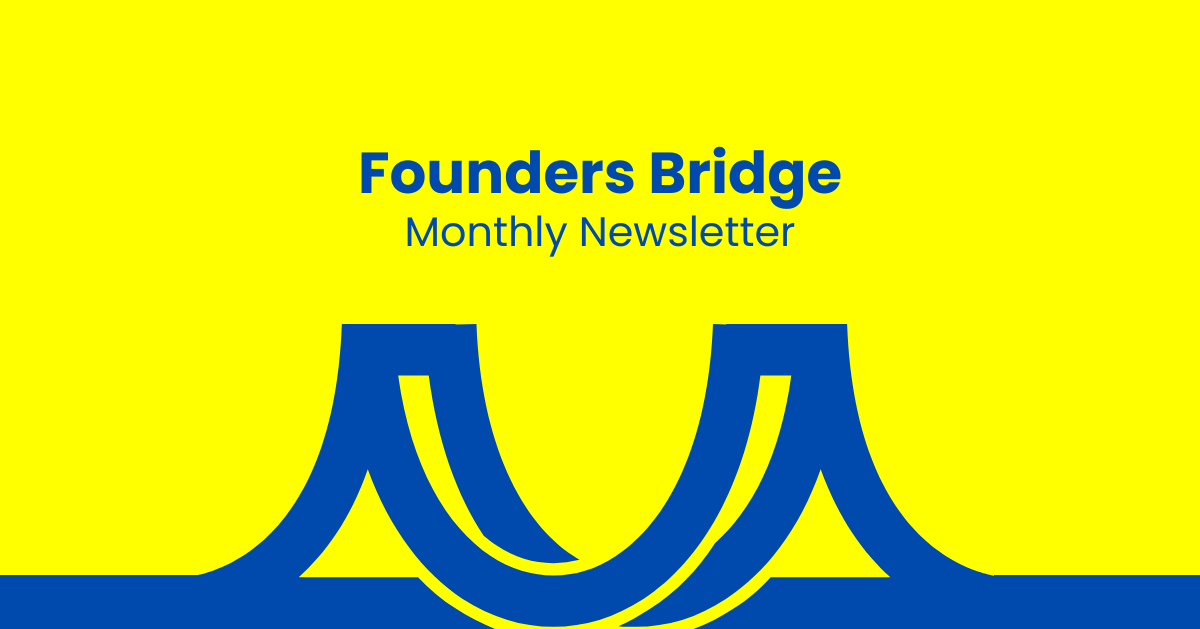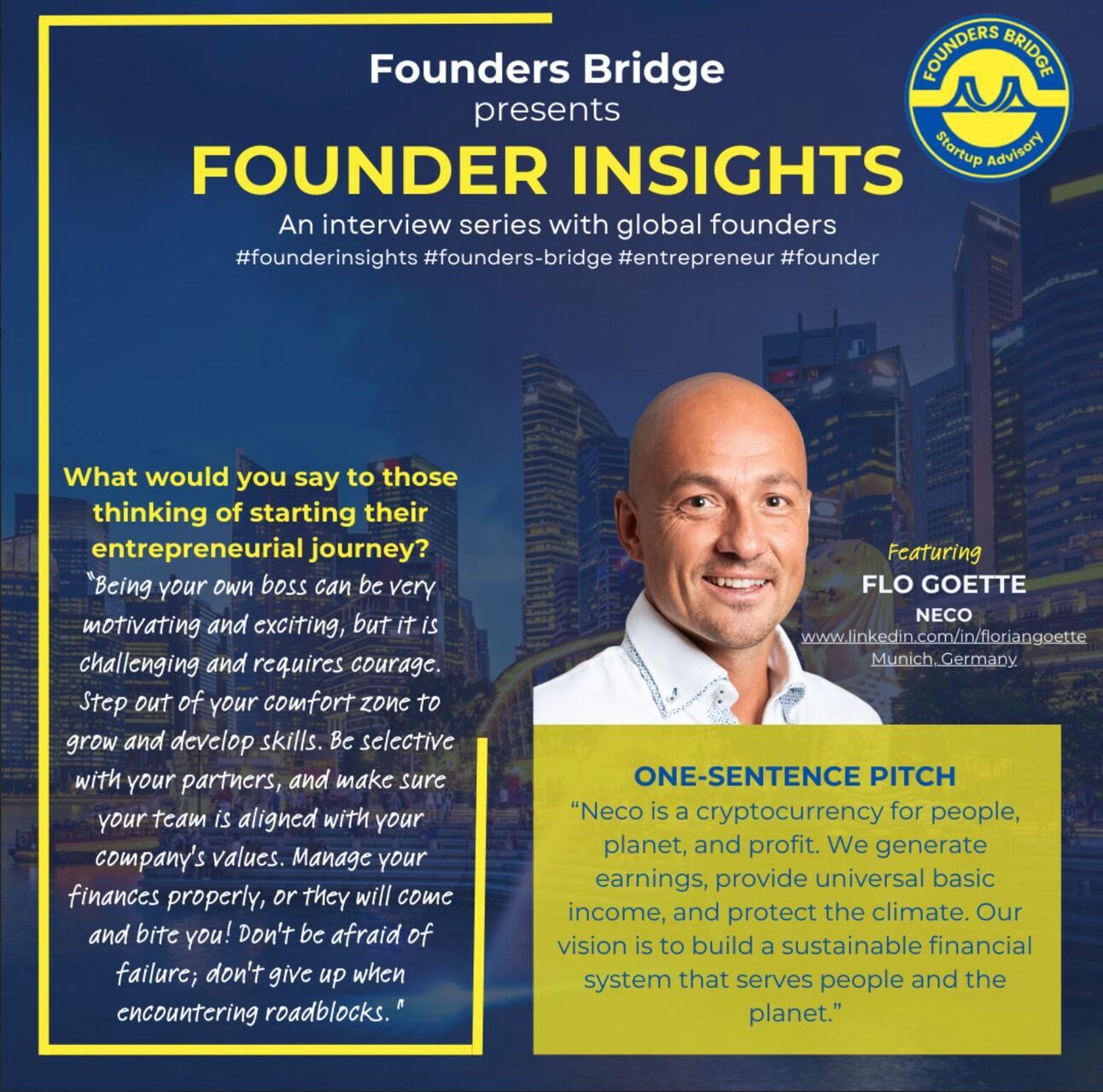- Founders Bridge
- Posts
- Tools, Insights, and Expert Guidance for Early Stage Startups
Tools, Insights, and Expert Guidance for Early Stage Startups
Founders Bridge - July 2024
Tools, Insights, and Expert Guidance for Early Stage Startups
Founders Bridge - July 2024
Dear Founders,
Welcome to the July edition of the Founders Bridge Monthly Newsletter! I am thrilled to have you join us on this journey. At Founders Bridge, we are committed to providing the insights, tools, and support you need to navigate the complex landscape of startup growth, international expansion, and fundraising. Over the past five years, we have had the privilege of mentoring hundreds of founders and helping them raise millions of dollars. We are excited to share our knowledge and expertise with you.
Sincerely,
Douglas Peris
Partner, Founders Bridge
In This Issue:
Tip of the Month: Essential Steps for Early-Stage Founders
Bridge Toolbox: Must-Have Tools for Startup Success
Founder Success Story: Scaling New Heights
Expert Insights: Navigating the Investor Landscape
Expert Advice: Crafting a Winning Pitch Deck
Q&A with Our Advisors

Tip of the Month: Validating idea for Early-Stage Founders
Validating your business idea is a critical step in the startup journey, ensuring that your concept has a viable market before you invest significant time and resources. Here are some practical tips and strategies to effectively validate your idea, along with real-life examples of how successful startups achieved this:
Conduct Market Research
Surveys and Interviews: Create detailed surveys and conduct interviews with your target audience to gather qualitative and quantitative data. Ask about their pain points, current solutions, and willingness to pay for a new product.
Focus Groups: Organize focus groups to observe how potential customers interact with your product concept and gather in-depth feedback.
Example: Airbnb founders Brian Chesky and Joe Gebbia initially rented out air mattresses in their apartments and personally interviewed their first users. This hands-on approach provided invaluable insights into customer needs and preferences.
Build a Minimum Viable Product (MVP)
Prototype Development: Create a basic version of your product with just enough features to attract early adopters and validate your concept.
User Testing: Test the MVP with a small group of target customers, gather feedback, and iterate quickly based on their input.
Example: Dropbox founder Drew Houston created a simple demo video to showcase the product’s potential. The video attracted significant interest and helped validate the idea before full-scale product development began.
Run Pilot Programs
Limited Launch: Introduce your product to a limited audience or a specific geographic area to test market response.
Collect Feedback: Use pilot programs to collect detailed feedback and make necessary adjustments before a broader launch.
Example: Uber started as a luxury car service in San Francisco, allowing the founders to test the concept, gather feedback, and refine the business model before expanding to other cities and services.
Other tips: Analyze Competitors, Leverage Social Media and Online Platforms such as Crowdfunding Campaigns, and Offer Pre-Orders and Beta Access
Read the full guide here: [LinkedIn Newsletter]
Toolbox: Must-Have Tools for Startup Success
Equipping your startup with the right tools is crucial for streamlining operations and boosting productivity. One essential tool that stands out in the LinkedIn automation space is Dux-Soup.
Overview: Dux-Soup is a powerful LinkedIn automation tool designed to handle your entire sales pipeline. It tracks your performance, manages outreach, and ultimately helps you close more deals. Whether you’re seeking beta users, potential partners, angel investors, or accelerating lead generation, Dux-Soup can significantly enhance your LinkedIn efforts.
Key Features:
Automated Profile Visits: Automatically visit LinkedIn profiles, which can trigger curiosity and lead to profile views in return.
Personalized Messaging: Send customized connection requests and follow-up messages, maintaining a personal touch at scale.
Data Export: Export LinkedIn data to your CRM or other tools for seamless integration and analysis.
Performance Tracking: Monitor key metrics such as connection acceptance rates, message response rates, and overall campaign effectiveness.
Benefits:
Time Savings: Automates repetitive tasks, freeing up time for strategic activities.
Improved Efficiency: Streamlines the process of managing connections and communication.
Enhanced Lead Quality: Targets the right audience with personalized messages, improving the quality of leads.
LinkedIn Optimization: A Crucial Step
Regardless of your startup stage, optimizing your LinkedIn profile and business page is essential for establishing a professional presence and attracting the right connections. A well-optimized LinkedIn profile can:
Enhance Visibility: Improve your search rankings within LinkedIn and increase the chances of being found by potential partners, investors, and customers.
Build Credibility: Showcase your expertise, achievements, and professional journey to build trust with your audience.
Drive Engagement: Encourage meaningful interactions and engagement with your content, leading to more opportunities.
Need Help? If you require assistance optimizing your LinkedIn profiles and business page, we have an agency partner specializing in startup growth who can help. They offer expert services to ensure your LinkedIn presence is compelling, professional, and effective in reaching your goals.
By leveraging tools like Dux-Soup or other similar tools and optimizing your LinkedIn profile, you can significantly boost your startup’s visibility, engagement, and success.
Founder Success Story: Scaling New Heights
NECO – THE ONLY CRYPTOCURRENCY THAT HAS NEVER LOST VALUE!
Meet Flo Goette, Founder and Chairman of Neco Finance, a social entrepreneur, impact investor, and visionary with a successful track record of four start-ups and a multi-million dollar acquisition. His latest venture, Neco, is revolutionizing the financial system.
While on an expedition in the Amazon rainforest, Flo was struck by a vision of a world filled with peace, abundance, and environmental health. This personal journey led to the creation of Neco, a cryptocurrency firm with a philanthropic and environmental focus.
I coached Flo during an accelerator program in early 2022 and witnessed his dedication firsthand. As a Neco investor and friend, I believe in the vision and impact of this innovative cryptocurrency.

Securing investment can be one of the most challenging aspects of growing your startup, but understanding the investor landscape and approaching it strategically can make a significant difference. Here are some practical tips and detailed strategies to help you navigate this complex process:
Know Your Investors
Research Thoroughly: Look into potential investors’ portfolios to understand their investment preferences and track record. Platforms like Crunchbase, AngelList, and LinkedIn can provide valuable insights.
Align Interests: Ensure that the investors you approach have a history of investing in your industry or business model. This increases the likelihood of them being interested in your startup.
Understand Their Criteria: Different investors have different criteria for making investments. Some might prioritize early traction, while others look for innovative technology or strong team dynamics.
Tailor Your Pitch
Customize Your Presentation: Adjust your pitch to highlight aspects of your business that align with the specific interests of each investor. For example, if an investor values market potential, emphasize your market size and growth opportunities.
Address Concerns Proactively: Anticipate potential objections or concerns investors might have and prepare well-researched responses to address them effectively.
Use Data and Stories: Combine hard data with compelling stories to make your pitch more engaging. Share customer testimonials, success stories, and case studies to illustrate your points.
Show Traction
Demonstrate Market Validation: Provide evidence that there is demand for your product or service. This could include user metrics, sales figures, pre-orders, or customer feedback.
Highlight Growth Metrics: Share key performance indicators (KPIs) that show your startup’s growth potential, such as user acquisition rates, revenue growth, and customer retention.
Showcase Partnerships: Mention any strategic partnerships or collaborations that validate your business model and enhance credibility.
Build Relationships
Network Strategically: Attend industry conferences, pitch events, and networking sessions to connect with potential investors. Building relationships over time can lead to more investment opportunities.
Leverage Introductions: Use your network to get warm introductions to investors. A referral from a trusted source can significantly increase your chances of securing a meeting.
Maintain Communication: Keep potential investors updated on your progress, even if they don’t invest initially. Regular updates can keep them interested and open doors for future investment.
Read More: Explore Various Funding Sources
Expert Advice: Crafting a Winning Pitch Deck
Emphasize Your Unique Value Proposition (UVP) Clearly and Early
Why It Matters: Investors need to quickly understand what makes your startup unique and why it's worth their attention. A strong UVP sets you apart from competitors and captures interest from the outset.
Practical Tip: Place your UVP prominently within the first few slides, ideally on the second or third slide. Use clear and concise language, supported by a compelling visual that illustrates your core value.
Example: Instead of simply stating "We offer a new social media platform," specify "We provide the only social media platform that integrates real-time language translation, enabling global connections without language barriers."
Detail Your Go-to-Market Strategy with Milestones and Metrics
Why It Matters: A well-defined go-to-market strategy shows investors that you have a clear plan for acquiring customers and scaling your business. It demonstrates foresight and reduces perceived risk.
Practical Tip: Include a slide that outlines your go-to-market strategy, detailing specific milestones, timelines, and metrics you will use to measure success. Highlight any initial traction or pilot programs to add credibility.
Example: Instead of saying "We plan to target millennials through social media," specify "In Q1, we will launch targeted Facebook and Instagram campaigns aiming for a 5% conversion rate, followed by influencer partnerships in Q2 to drive a 20% increase in brand awareness."
Q&A with Our Advisors
As valued members of our community, you have exclusive access to our team of expert advisors who specialize in accelerating growth, developing new markets, expanding internationally, and raising funding between USD$ 500,000 and $20M for high-potential start-ups and SMEs.
If you have any questions or need guidance, send us a reply with your question, and we will feature it with our answers in the next edition of the newsletter.
Thank you for being a part of the Founders Bridge community. We look forward to helping you achieve your business goals.
Best regards,
Doug
About Founders Bridge
Founders Bridge is a specialist business advisory firm focused on helping start-up founders and SMEs navigate key growth challenges. Our core services include business growth strategy, international expansion, and fundraising support. We are committed to your success and dedicated to providing the expertise you need to thrive.